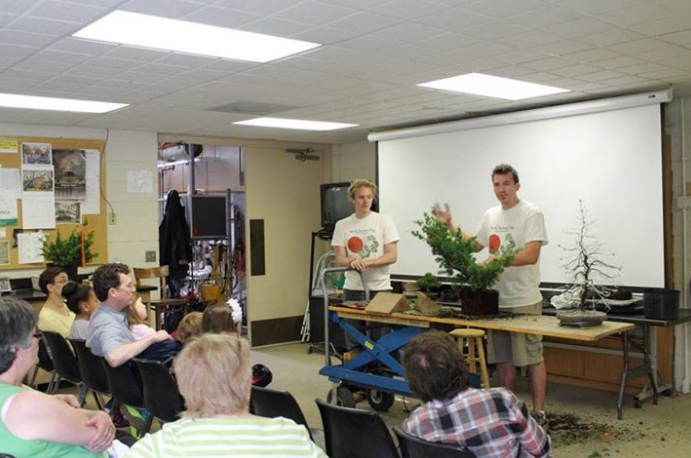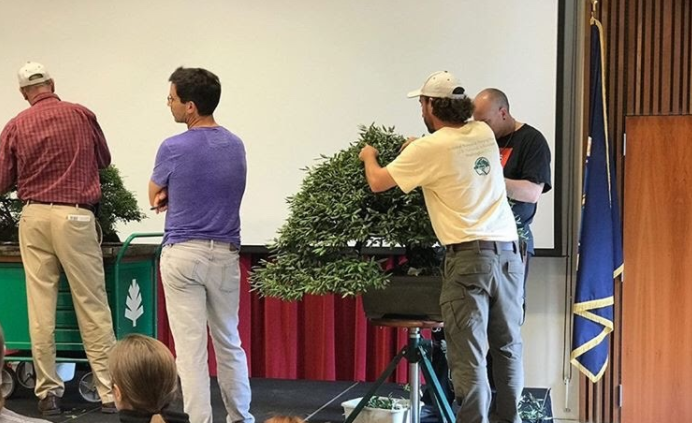This tokonoma display was featured in the 2017 World Bonsai Day celebration. Spot the World Bonsai Friendship Federation logo on the scroll in the background!
When Master Saburo Kato gave a moving speech at the International World Bonsai Convention in Hawaii in 1980, he emphasized the idea of “bonsai no kokoro,” or the “spirit of bonsai.” National Bonsai Foundation Co-Presidents Jack Sustic and Felix Laughlin said the Japanese term expresses the idea that practicing the art and horticulture of bonsai raises one’s awareness of the beauty and fragility of nature and opens up one’s consciousness to the wonders of the natural world.
Then-assistant curator Aarin Packard and intern Danny Coffey lead a demonstration at the 2013 World Bonsai Day celebration.
Kato would go on to repeat this sentiment in many speeches, inspiring bonsai artists around the globe. In Japan in 1989, he co-founded with John Naka and Ted Tsukiyama the World Bonsai Friendship Federation (WBFF), which exists to bring peace and camaraderie to the world through bonsai.
“Kato believed from the bottom of his heart that more peace would exist in the world if everybody practiced the art of bonsai,” Sustic said.
After Kato passed in 2008, WBFF established an international day of celebration called World Bonsai Day to pay homage to Kato and his efforts to promote peace and friendship through bonsai. The first event was held in 2010, and the day is now celebrated on the second Saturday of May each year, around the time of Kato’s birthday, May 15.
Sustic said the National Bonsai & Penjing Museum and U.S. National Arboretum generally celebrate the day with demonstrations, tours of the Museum and a special display of one of Kato’s trees. Some years the Museum raffles off the tree volunteers work on during the festivities. Sustic said the most memorable part of World Bonsai Day for him is seeing the excitement and amazement on the face of the person who wins that tree.
“Hopefully that leads to another person doing bonsai who otherwise wouldn't be doing bonsai or would never have been introduced in the first place,” he said.
Laughlin said WBFF established centers around the globe to link public collections together, and a criterion for centers is to recognize World Bonsai Day.
“Some people who first get into bonsai might think it's just a hobby, but it has a much deeper meaning,” Laughlin said. “In celebrating Saburo Kato's legacy, we're reaffirming what it truly means to practice bonsai. Kato really was such a great person, poet and teacher, and he could put the meaning of bonsai into words better than anyone else.”
Former curator and current NBF Co-President Jack Sustic leads a tour in the upper courtyard at the 2015 World Bonsai Day celebration.
Museum Curator Michael James said the most memorable World Bonsai Day celebration for him was when he and Museum volunteers spent the day working on a forest planting donated by NBF Honorary Director Chase Rosade. He said the group’s goal was to incorporate Kato’s concepts and principles of forest plantings into the design.
The National Bonsai Foundation translated Kato’s book, “Forest, Rock Planting and Ezo Spruce Bonsai,” into English and published it in 2001.
Rosade had arranged zelkova seedlings he brought home from Japan into a forest planting. The groupings are planted in odd-numbered groups of three or five and up to 17 to emulate the spontaneity of how seeds are dropped and grow in a naturally occuring forest. But Rosade’s grouping had so many zelkova that the arrangement appeared symmetrical and planned.
Saburo Kato stands next to one of his famous forest plantings at his nursery Mansei-en in Omiya, Japan.
In the public demonstration for that year’s World Bonsai Day, volunteers removed seedlings to thin the forest, accentuate the primary trees and emulate the randomness that occurs in nature – a concept Kato developed and taught about.
“Kato was a total master of forest arrangements and compositions,” James said.
Last year’s World Bonsai Day attendees gathered to watch Bonsai Master Michael Hagedorn direct work on five Museum trees in the Arboretum’s auditorium.
James added that the celebration helps promote international camaraderie around an activity generally recognized as a solitary endeavor between the practitioner and the tree. ”World Bonsai Day is not only enjoyable for that person practicing by themselves, but it brings them together with everyone else who enjoys it,” he said. “When you enjoy doing bonsai, it’s only natural to want to spend and appreciate it with other friends.”
NBF is glad we could share World Bonsai Day with you this year. Use #WorldBonsaiDay2020 and tag us in the photos you post on Instagram, Facebook and Twitter to help us encourage unity and peace.






